Sections
Pick of the Week
The mobile industry used to be configured differently from the rest of the consumer technology sector and for much of its early history a phone was essentially a “toy for rich people”. That situation started changing in 2007 around the time iPhone and low cost Android arrived and fired wider ownership aspirations. Now 85% of the world’s population has a mobile phone and that phone is ever more likely to be an Android smartphone. To put this figure into perspective it is “more than mains electricity (80%) and close to the same as access to improved water (90%)”.
Smartphones have essentially morphed into a fast moving consumer goods (FMCG) category with such global reach that it resembles the profile of other essential goods where the same raw material is repackaged for different users: “This makes the concept of a ‘customer’ on the internet look much more like, say Unilever’s: there are people buying soap by the gallon and people buying it in sachets.” All the while, it has become progressively easier and cheaper to enter the smartphone market by leveraging a global electronics supply chain centred around the Taiwanese ODMs and Android productisation partners. These factors help explain why so many established and new outfits that in the past would have been considered unlikely OEMs are making and branding ‘good enough’ phones, a trend that is likely to accelerate over the coming years. It also explains why traditional handset manufacturers have this week come out with a slew of product announcements at IFA Berlin, a consumer electronics fair, acknowledging the changing market they are operating in.
In the FMCG world, brand recognition is more important than any specific technology advantage as customers will often make decisions based on fashion trends or convenience and the factors involved are frequently beyond what is the ‘best’ phone, a situation ripe for disruption by (among others) global megabrands and multi-channel retailers. A recent NYT article highlighted how important having the ‘right’ phone is to teenagers in the US: “Having a cool phone to show you’re plugged in is a huge part of people’s style, a huge part of life these days,” said Eva Chen, editor in chief of Lucky Magazine, adding that teenagers used smartphones to signal status in the way men used to do with ornate watches.”
There’s a conundrum in here. Ornate watches aren’t made on an industrial scale with built-in obsolescence driven by an 12-18 month lifecycle. Designing a desirable, high quality product that will endure takes time as Frank Nuovo, ex-Nokia design chief points out in a thoughtful Gizmodo interview: “We live in an age of instant gratification – allowing ideas to be developed quickly with CAD tools” but “it takes an extraordinary amount of hard work and long hours to make something truly special with long lasting success.” He has called upon his vast premium design expertise to help develop the Meta smartwatch which The Verge called “the watchmaker’s smartwatch” and which TechCruch also reviewed very favourably: “The watch has been very easy to wear and, more important, lasted almost a week on one charge, a truly amazing feat in the smartwatch world. While beauty is in the eye of the watch wearer, I can say that the M1 is finally a smartwatch that I’d wear with regularity and, even given the potential for future Apple wearables, I’d wear this thing over a color OLED unit any day.” It’s an opinion worth bearing in mind in the light of purported comments by Jonny Ive: “According to a designer who works at Apple, Jonathan Ive, Apple’s design chief, in bragging about how cool he thought the iWatch was shaping up to be, gleefully said Switzerland is in trouble — though he chose a much bolder term for “trouble” to express how he thought the watchmaking nation might be in a tough predicament when Apple’s watch comes out.” As The Register points out, there is an extreme category of products, Veblen goods, which operate under quite different economics from those of FMCG or even a premium iWatch in that they become more attractive the scarcer they are.
/cdn2.vox-cdn.com/uploads/chorus_asset/file/679666/meta-watch-1_2040.0.jpg)
Smartphones/OEMs
- In a busy week at IFA in Berlin, Motorola stood out. They made major announcements across their product range covering significant update to their Moto X and Moto G smartphones, the launch of their 360 Android Wear smartwatch and an interesting new tiny Bluetooth earbud called the Moto Hint which The Verge are calling “the future of the Bluetooth headset”. The Moto X and Moto G updates cover chipset, software and mechanics. Moto X now incorporates an aluminium frame and employs materials like leather and wood for the back plate: “We think the [specifications] game doesn’t work with consumers any more,” Christoph Jeneba, Motorola’s head of product for Europe, the Middle East and Africa, told to the Guardian. “We have to offer more to differentiate ourselves from the competition.” AnandTech published a detailed hands on and PocketLint really liked it: “[Moto X] moves into real flagship territory, challenging the proposition of some of the best Android devices out there. Moving on from the odd mid-range that the Moto X previously occupied is good, as Motorola now has a flagship device.” Both Moto X and Moto G are on Android 4.4.4 and are positioned for an update to L something that is easier for Motorola now they are closer to stock Android on their smartphones. WSJ went hands on with the Moto 360 smartwatch which starts shipping today retailing at $250. Although they liked the industrial design, they had some concerns about software readiness and excessive notifications.


- Asus announced the Zen smartwatch at IFA. It’s an interesting combination of AndroidWear and a classic watch design. Asus also appear to have integrated an interesting collection of neat features including built-in heart rate monitor and pedometer as well as phone integration: “A neat feature of the ZenWatch is how it can be used to find your phone (providing you’re within around 10 metres). Double tapping the watch screen makes the phone ring.” Also “your connected phone automatically unlocks when it senses the ZenWatch is nearby, saving you from repeatedly entering your password or PIN each time you want to check your phone.” On the downside, the battery life is claimed to be just one day meaning you’ll have to charge your watch every night.
- Alcatel also got in on the IFA act with their own smartwatch concept that interestingly isn’t running Android Wear:

- CAT have been quietly building a reputation for building super rugged Android phones suitable for outdoor types like yachties. They just announced at IFA a new KitKat based smartphone, the S50. It’s a very manly phone:
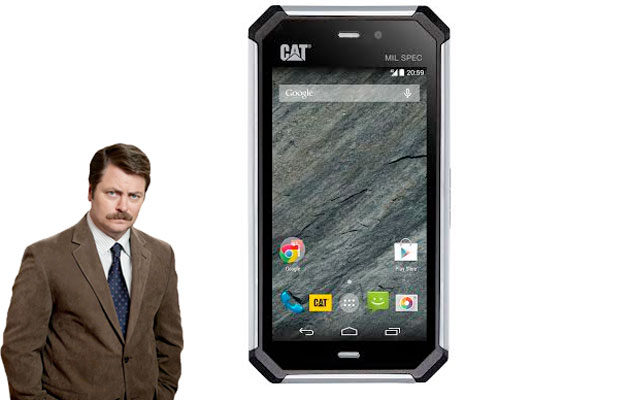
- Sony had a very busy week at IFA. First up they announced the Xperia Z3 as their next flagship Android smartphone. It’s an incremental improvement on the Z2, itself only a few months old. The main difference is an upgrade of chipset to Snapdragon 801, an improved 20.7 MP camera and all round a lighter and thinner body.
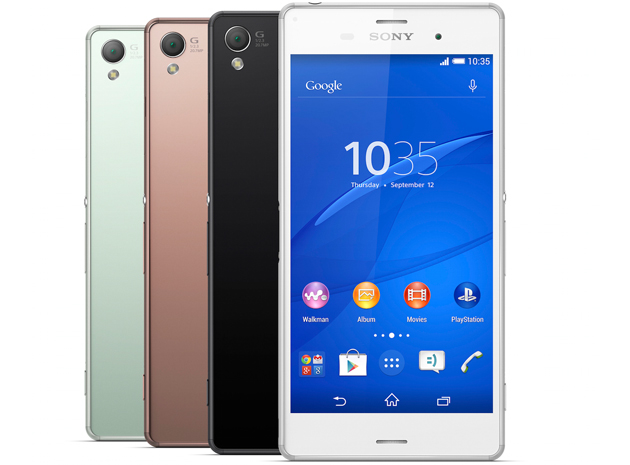
- Sony also announced SmartWatch 3, the third iteration of their smartwatch now based on Android Wear and another iteration of their Smartband, the Smartband Talk, this time with an e-paper screen and voice calling: “Its big new feature is HD Voice support with an integrated microphone and speakers to let you conduct phone calls directly on the band. It also has a nice trick of letting you remotely control music on other devices and start and stop it with a snap of your fingers (it senses the movement of the wrist rather than listening out for a particular sound)”. The Verge went hands on with both devices and weren’t exactly overwhelmed. According to Engadget, they’re both also compatible with Sony’s Lifelog Android app.

- Bloomberg profiled Lee Jae Yong who is widely believed to be next in line to lead Samsung. Jay Y as he’s known is the son of current Samsung chairman Lee Kun Hee who remains profile in South Korea: “Samsung is a religion, and Chairman Lee is a god.”
Apple
- Apple started the week having to deal with what was initially reported as an iCloud security leak resulting in the release of dozens of private celebrity photos via 4chan. Commentators were quick to pick up on the story with some like SilentCircle using it as an opportunity to extol the virtues of their own security software. Apple released a statement after a short investigation which indicated that the attack had not been a system compromise as such but a combination of brute force and poor password and security question selection: “To protect against this type of attack, we advise all users to always use a strong password and enable two-step verification. Both of these are addressed on our website at http://support.apple.com/kb/ht4232“. Later in the week Apple also announced a greater focus on two-factor authentication (TFA) and enhanced iCloud security notification support: “Email and push notifications will also alert users when someone tries to change the account password or log into the account from a new device”. Apple’s TFA implementation seems to be in need of an overhaul to offer full protection – switching it on is not entirely straightforward.
- Anand Lal Shimpi, editor and publisher of the highly-regarded AnandTech site which provides detailed technical product reviews, is heading off to work at Apple. It’s not entirely clear what he’ll do when he gets there.
- With iPhone6 launch imminent there are persistent indications that NFC payment will be a key feature supported by NXP technology and merchants including Amex and Visa. The FT point out that Apple already hold 800 million customer credit card details so have a huge opportunity to kick start a mobile payments industry that is yet to take off.
- Ahead of iOS8 launch, Apple have set strict guidelines for developers seeking to use HealthKit data. There appear to be a wide range of privacy and FDA regulatory grounds on which your app can be rejected as well as a general catch all: “If your app is plain creepy, it may not be accepted”. Presumably the same criteria won’t necessarily apply to Apple’s own Health app which will potentially be able to aggregate anonymised information from millions of users. 9to5mac also suggest “some accessory manufacturers will be able to skip the process of developing a companion app for their product and instead allow HealthKit to automatically connect to and control the device itself. ” The sort of accessories cited include “heart rate and blood pressure monitors, glucose sensors, and health thermometers” that support the corresponding official standard BTLE based profiles: “Not only will HealthKit automatically establish a connection with devices in range, it will also handle gathering data, saving it in the Health app and notifying other apps that might want to access the data via the HealthKit API.”
- As many continue to speculate on iPhone6 launch, and fans start forming lines outside Apple stores for products that are yet to be unveiled, here’s a timely reminder of the Apple Product Cycle:

Apps/Google/Android
- This unintuitive.com blog post sets out what would be a game changer in the world of app development, namely a system that can be downloaded and running code on a device “within five minutes” and is so powerful and easy to use it allows designers to get hands on developing without being dependent on a developer to do the work for them: “It is 2014 and it is crazy that for most mobile apps every UI elements is positioned by a developer.” Critical to such an environment would be the language employed to allow designers to think and work efficiently with user interface creation and manipulation. An interesting book exploring some of this territory is Bonnie Nardi’s A Small Matter of Programming.
- Google have curated a collection of “beautiful apps” on Google Play which they claim showcase the best of Android. All have already incorporated elements of Android L Material Design with fast, clean transitions, avoidance of skeuomorphism and crisp layout and typography. They include AirBnB, Spotify and Duolingo.
- The Atlantic secured exclusive access inside Google’s Project Wing “a secret drone program that’s been running for two years at Google X” focussing on delivering products across a city in “a minute or two”. Interesting insight into a Google moonshot inspired in part by the Pony Express.
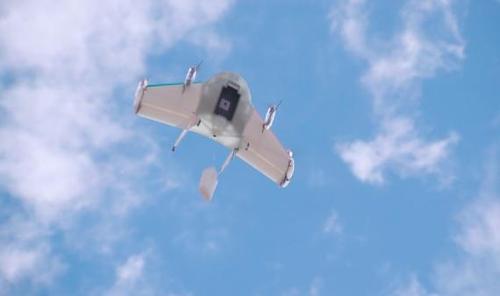
Asia
- TNW survey the complex and dynamic world of Android app stores in China and the crucial role played by Tencent’s WeChat in establishing the conditions to legitimise payment for content and apps.
- This brief native perspective on the Android scene in China is revealing. Powerful ecosystem dynamics are dramatically lowering the barrier to entry: “Thanks to chip solution providers like Taiwan-based MediaTek, a plenty of OEMs in China and the open-source Android system, making smartphones became so much easier.” The result echoing the theme of the week is that literally anyone can have a go at making an Android phone. What is going to be harder is building the brand to support it.
Big Data/Machine Learning
- According to GigaOM Baidu’s “100-billion-neuron deep learning system” is going to be “complete within six months”: “Thanks to smartphones and its new Baidu Eye technology, the company expects voice and image search to dominate within five years.”

- Meanwhile NYT published an interesting piece on the future of data science which quotes from leading researcher and chief executive of the recently created Allen Institute for Artificial Intelligence who is less enthusiastic about prospects: “Computers can’t experience the world as humans do. And Etzioni is skeptical of the progress that will be possible with “deep learning,” an artificial intelligence technique that uses the structure of the human brain as metaphorical inspiration for computer systems that process huge amounts of data.” The article suggests leaders in the field are converging on the longer-range promise for data science led software being “technology that becomes a layer of data-driven artificial intelligence that resides on top of both the physical and digital worlds, helping people to make faster and smarter decisions as a kind of clever software assistant.” Not far from Michio Kaku’s idea of the Magic Mirror. It would have to work out how to reason with ambiguous sentences like this: “The large ball crashed right through the table because it was made of Styrofoam.”
- BigML’s Andrew Shikiar’s posted a fun article about an experiment in which he used BigML and import.io to try and answer a question: “are there hidden factors in a Kindle book’s data that are impacting its rating?” It turns out from analysing 58000 titles that there is – “to write a highly-rated Kindle title on Amazon, it’s going to be have something to do with God and inspiration.”
Wearables/InternetOfThings
- iBeacon technology remains a potent and disruptive change agent in the retail world. As this HBR post puts it “implementing beaconing is less about installing the actual beacons and much more about rethinking the overall shopping experience they can help shape”. The article suggests that a lot of exploration is going on in small scale trials by major retailers: “Since the best way to imagine the possibilities is through actual, small-scale deployments, this has been how many retailers have spent the past several months, quietly experimenting and learning. Now, many are ready to scale up their initiatives, and beacons are bursting onto the scene in a big way.” An example of this is Regent Street where “London’s mile-long, high-end shopping street has some 140 store entrances, and now has beacons at the entrances of many of them. The beacon app used is the Regent Street app, slated to be promoted on the sides of double-decker buses that run along Regent Street. The app allows shoppers to pre-select the categories that interest them and the ones that don’t, making the messages they receive more relevant to them.”
- Android Wear is beginning to gather momentum after a bit of a slow start and “the Android Wear team plans to ship “several” updates to the platform before the end of the year”. Planned feature updates “include support for GPS on devices, instead of having to rely on connected smartphones, and the ability to work with other Bluetooth wearables in potentially interesting ways.”
- Drinkmate is a “tiny plug-in breathalyser for Android devices” on Kickstarter. The promo video has some funny touches and runs like a spoof:
- Garmin just announced the Vivosmart smartband which looks like the successor to the popular Garmin Vivofit. Retailing at $170 the Vivosmart is “a fitness tracker that shows texts, emails, calls, calendar appointments, game notifications and music playback controls.” Engadget reckon that “for the time being, at least, it might just be the most versatile fitness device you’re going to find.”
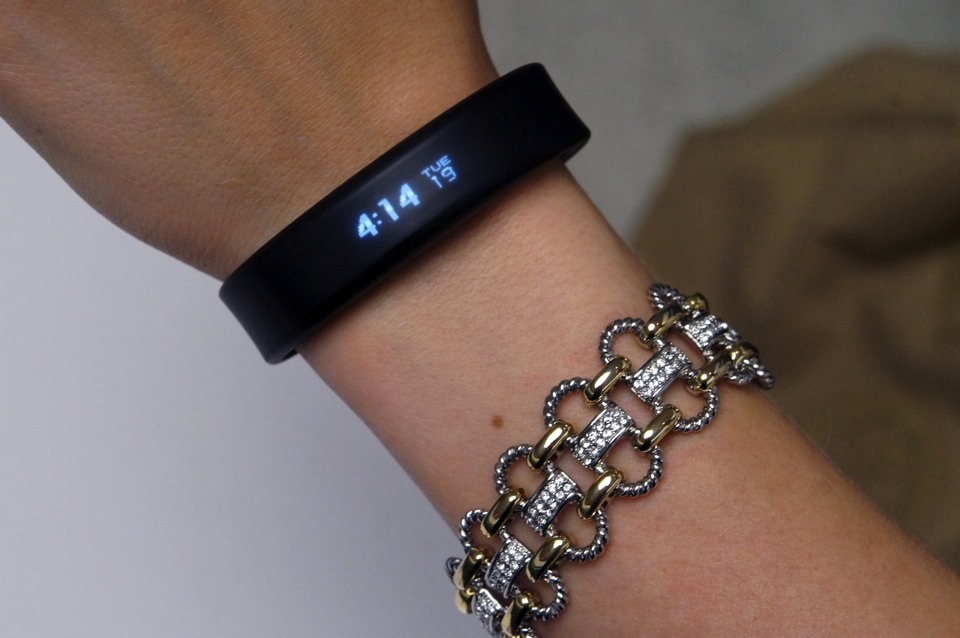
- Intel have revealed an altogether more upmarket smartband which is closer to a piece of jewellery slated to retail at nearly $1000. It’s called the MICA (My Intelligent Communication Accessory) and it’s positioned as a “notification-bracelet” which will be available at Opening Ceremony and Barney’s in the US soon. According to USA Today: “The MICA bracelet comes in two styles: One features a black snakeskin design, pearls and lapis stones from China; the other is white snakeskin, tiger’s eye from South Africa and obsidian from Russia.”
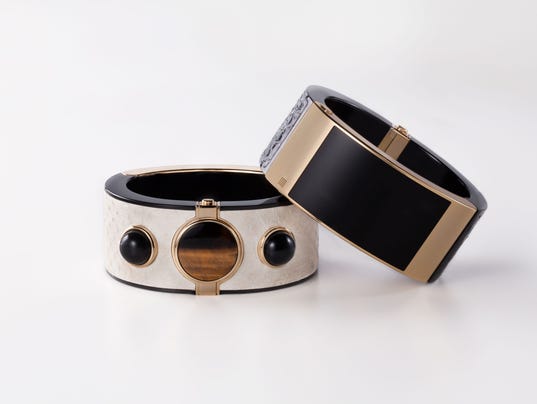
- Softbank’s Pepper robot is coming to the US “within a year”. Will he be able to do anything useful beyond being a cute mobile iPad holder?
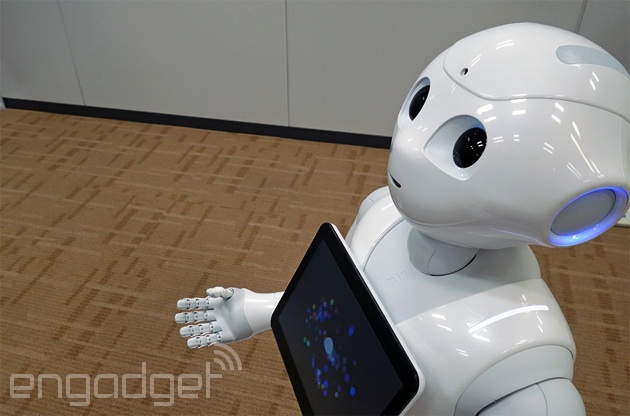
Programming
- 30 years on from the Acorn BBC Micro, the BBC is gearing up to help support the new computing curriculum with a code literacy push backed by programming-themed children’s TV output in the autumn. Computing material will also be boosted on their education focussed Bitesize site. The BBC posted this interview with a sparky 10-year old called Max who “loves coding” and dislikes ICT correctly identifying that “the people who wrote Word didn’t use Word to write Word” and that in any case “Word is rubbish, you’re never going to use Word as a job”. Wait till he grows up.
- The NYT preview some mobile apps intended to help you understand the basics of programming. Codecademy Code Hour and Lightbot in particular stand out. The latter integrates gamification with coding concepts in a fun way with a robot figure that has to navigate a maze turning on lights:
Work/Culture
-
Yet more evidence of the negative impact of social networks via a massive study conducted in Italy looking at correlation between extent of social network usage and subjective well-being gathered by measuring response to the question, “How satisfied are you with your life as a whole nowadays?” The researchers involved have gone to lengths to account for any bias in their results. Amongst their conclusions: “face-to-face interactions and the trust people place in one another are strongly correlated with well-being in a positive way. In other words, if you tend to trust people and have lots of face-to-face interactions, you will probably assess your well-being more highly.”
-
Our growing obsession with screens may come at another price. The Guardian recently cited a report “which found that readers using a Kindle were “significantly” worse than paperback readers at recalling when events occurred in a mystery story”. The plot reconstruction measure used involved identifying the order of 14 different events in a mystery novel. The research suggests that the tactile feedback from reading paper books is an important factor we use to measure progress: “When you read on paper you can sense with your fingers a pile of pages on the left growing, and shrinking on the right”. This is obviously less apparent on a Kindle.
- Good HBR piece on the importance of “CQ” or Curiosity Quotient when dealing with complexity in addition to the more widely understood IQ and EQ (“Emotional Quotient”): “CQ stands for curiosity quotient and concerns having a hungry mind. People with higher CQ are more inquisitive and open to new experiences. They find novelty exciting and are quickly bored with routine. They tend to generate many original ideas and are counter-conformist.”
- This InfoQ article on self-organising teams carries some echoes of Kanban/Scrum based approaches to software development. The intent is laudable but is likely to run aground in bigger more “political” organisations which are overwhelmingly heirarchical: “We use the role of the sports team coach as metaphor for the modern leader. We suggest that such leaders are unable to directly control the work of their team members, yet we argue that they nevertheless still have an essential part to play in the organisation.”

- Jeremy Clarkson tweeted “What does this even mean?” in relation to the following gnomic Accenture advert which seems to be aimed at those looking to make the case for technology strategy as a functional unit within their business – that is, not many of us:

